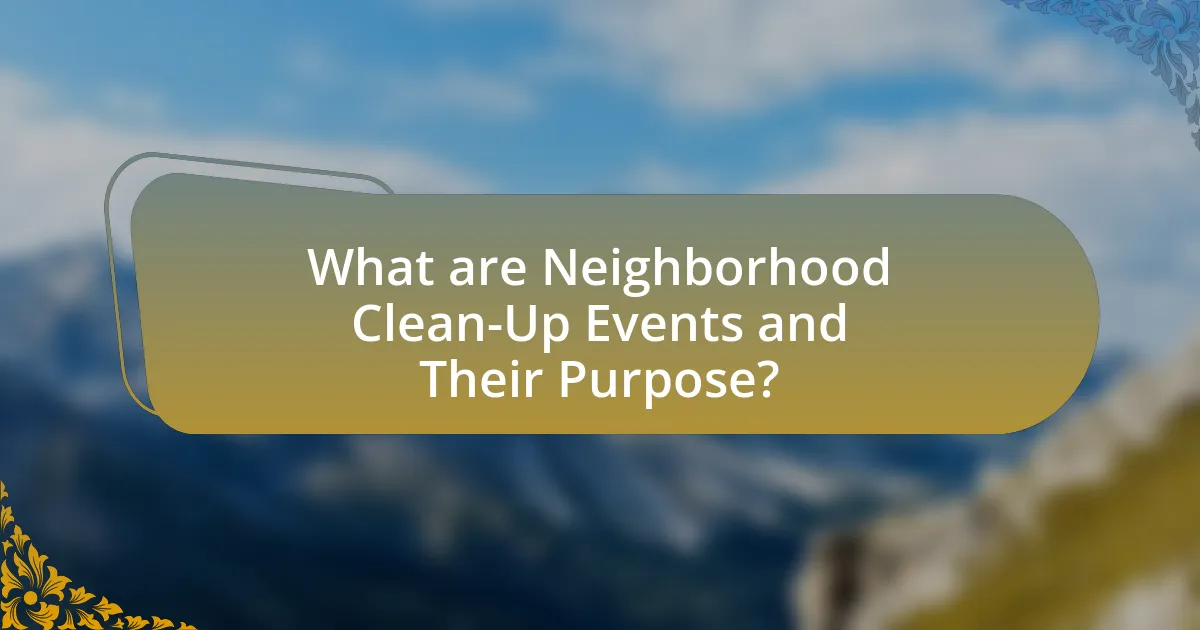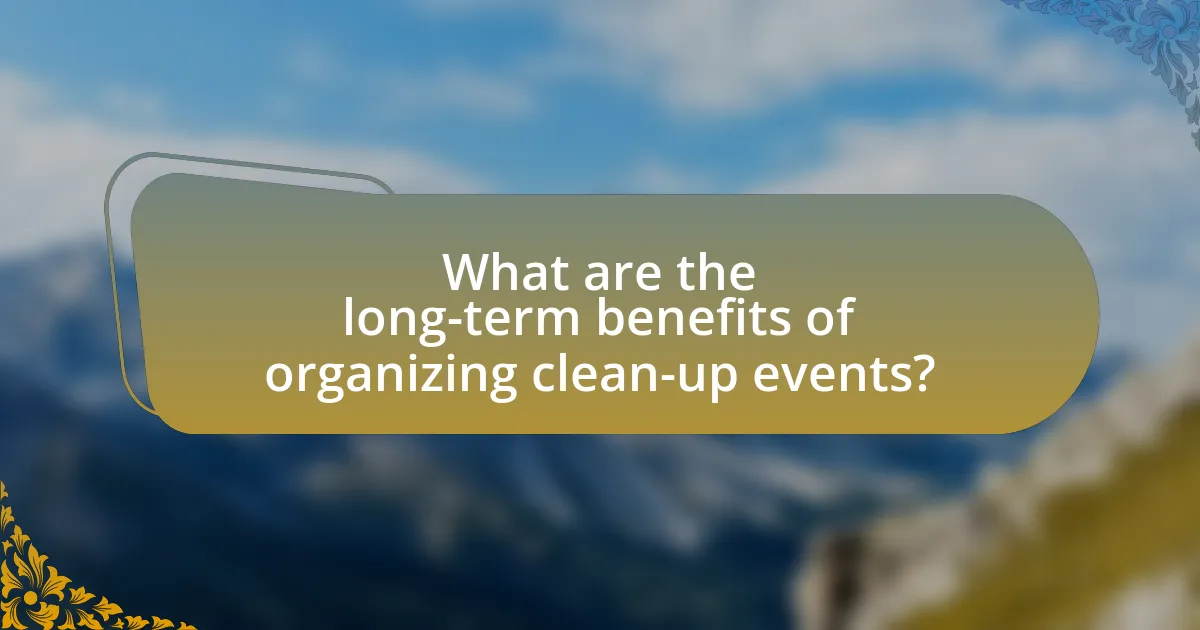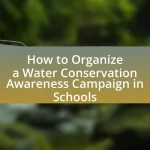Neighborhood clean-up events are organized community activities aimed at cleaning and beautifying local environments, with a significant focus on protecting water sources. These events help remove litter and pollutants that can contaminate waterways, thereby improving water quality and fostering healthier ecosystems. The article outlines the importance of community engagement, effective planning, and resource allocation in organizing successful clean-up initiatives. It also discusses the long-term benefits of these events, including enhanced community pride, increased volunteer participation, and improved environmental health. Additionally, the article highlights best practices for future clean-up events and the role of local businesses and organizations in supporting these efforts.

What are Neighborhood Clean-Up Events and Their Purpose?
Neighborhood clean-up events are organized activities where community members come together to clean and beautify their local environment. The primary purpose of these events is to remove litter and debris from public spaces, which helps improve community aesthetics, promotes environmental stewardship, and fosters a sense of community pride. Additionally, these clean-up efforts can protect water sources by preventing pollutants from entering waterways, thereby contributing to better water quality and ecosystem health. Studies have shown that community involvement in such initiatives leads to increased awareness of environmental issues and encourages sustainable practices among residents.
Why are Neighborhood Clean-Up Events important for water source protection?
Neighborhood Clean-Up Events are important for water source protection because they reduce pollution and debris that can contaminate local waterways. By organizing these events, communities actively remove litter, chemicals, and other harmful materials that could otherwise enter storm drains and rivers, leading to water quality degradation. Studies show that clean environments contribute to healthier ecosystems, which in turn support clean water sources. For instance, the Environmental Protection Agency highlights that community clean-up efforts can significantly lower the levels of pollutants in nearby water bodies, thereby enhancing aquatic habitats and public health.
How do these events contribute to reducing pollution in water sources?
Organizing neighborhood clean-up events directly contributes to reducing pollution in water sources by removing trash and debris that can contaminate waterways. These events mobilize community members to collect litter, which often includes plastics and chemicals that, if left unchecked, can leach into local water systems. For instance, a study by the Environmental Protection Agency indicates that community clean-up initiatives can lead to a significant decrease in pollutants entering water bodies, with some areas reporting up to a 30% reduction in surface litter after such events. This collective action not only cleans the environment but also raises awareness about the importance of maintaining clean water sources, fostering a culture of environmental stewardship within the community.
What role do community engagement and awareness play in these events?
Community engagement and awareness are crucial in organizing neighborhood clean-up events to protect water sources, as they foster participation and collective responsibility among residents. Engaged communities are more likely to mobilize volunteers, leading to higher turnout and more effective clean-up efforts. Awareness campaigns educate residents about the importance of clean water and the impact of pollution, which can motivate individuals to take action. For instance, studies show that communities with strong engagement initiatives see a 30% increase in volunteer participation compared to those without such efforts. This demonstrates that informed and involved residents are essential for the success of environmental initiatives.
What are the key components of organizing a successful clean-up event?
The key components of organizing a successful clean-up event include planning, community engagement, resource allocation, and follow-up. Effective planning involves selecting a date, location, and specific areas to target for cleaning, ensuring that the event aligns with local regulations and environmental guidelines. Community engagement is crucial; it involves promoting the event through social media, local organizations, and flyers to attract volunteers and raise awareness about the importance of protecting water sources. Resource allocation entails gathering necessary supplies such as trash bags, gloves, and tools, as well as arranging for waste disposal after the event. Finally, follow-up activities, such as thanking volunteers and sharing the results of the clean-up, help maintain community interest and encourage future participation. These components are essential for maximizing participation and achieving environmental goals, as evidenced by successful clean-up initiatives that have led to significant improvements in local water quality and community pride.
What steps should be taken to plan a clean-up event?
To plan a clean-up event, first, identify the location that requires cleaning, focusing on areas that impact water sources. Next, set a date and time for the event, ensuring it does not conflict with other local activities. Then, gather volunteers by promoting the event through social media, community boards, and local organizations. After that, secure necessary permits from local authorities if required, and arrange for the collection and disposal of waste, including trash bags and recycling bins. Finally, prepare for the event by providing safety gear, refreshments, and clear instructions to volunteers on their roles and responsibilities. These steps ensure an organized and effective clean-up event that contributes to protecting water sources.
How can volunteers be recruited and motivated for participation?
Volunteers can be recruited and motivated for participation by clearly communicating the impact of their efforts on local water sources and community health. Engaging potential volunteers through social media campaigns, community meetings, and partnerships with local organizations can effectively raise awareness and interest. Providing incentives such as recognition, skill development opportunities, and refreshments during events can further enhance motivation. Research indicates that volunteers are more likely to participate when they feel a sense of community and purpose, as demonstrated in studies showing that community-driven initiatives lead to higher volunteer retention rates.

How can communities effectively organize clean-up events?
Communities can effectively organize clean-up events by establishing a clear plan that includes setting a date, identifying specific locations needing attention, and recruiting volunteers. A successful clean-up event often involves collaboration with local organizations, schools, and businesses to maximize participation and resources. For instance, a study by Keep America Beautiful found that organized community clean-up events can lead to a 30% increase in local volunteer engagement when supported by local businesses. Additionally, promoting the event through social media and local news outlets can enhance visibility and encourage more community members to join.
What strategies can be employed to ensure community involvement?
To ensure community involvement in organizing neighborhood clean-up events to protect water sources, strategies such as engaging local stakeholders, utilizing social media for outreach, and providing incentives can be employed. Engaging local stakeholders, including schools, businesses, and community organizations, fosters collaboration and builds a sense of ownership among participants. Utilizing social media platforms effectively reaches a broader audience, allowing for the dissemination of information and mobilization of volunteers. Providing incentives, such as recognition or small rewards, encourages participation and enhances community commitment. These strategies have been shown to increase volunteer turnout and foster a culture of environmental stewardship within communities.
How can local businesses and organizations be engaged in the process?
Local businesses and organizations can be engaged in the process of organizing neighborhood clean-up events to protect water sources by forming partnerships that provide resources, volunteers, and financial support. These collaborations can enhance community involvement and increase the event’s visibility. For instance, businesses can sponsor clean-up supplies or offer incentives for employee participation, while organizations can mobilize volunteers and promote the event through their networks. Research shows that community engagement initiatives, such as those led by local businesses, can significantly improve participation rates and foster a sense of ownership among residents, ultimately leading to more successful environmental outcomes.
What resources are available to support clean-up initiatives?
Various resources are available to support clean-up initiatives, including funding from government grants, non-profit organizations, and community sponsorships. For instance, the Environmental Protection Agency (EPA) offers grants specifically for community clean-up projects aimed at protecting water sources. Additionally, local municipalities often provide tools and equipment, such as trash bags and gloves, to assist volunteers during clean-up events. Non-profit organizations, like Keep America Beautiful, also offer resources, including educational materials and volunteer coordination support, to enhance the effectiveness of clean-up efforts. These resources collectively empower communities to organize and execute successful clean-up initiatives.
What challenges might arise during the organization of clean-up events?
Challenges that might arise during the organization of clean-up events include logistical issues, volunteer engagement, and resource allocation. Logistical issues can manifest as difficulties in securing permits, coordinating transportation for volunteers, and ensuring access to clean-up sites. Volunteer engagement may be hindered by a lack of interest or awareness in the community, leading to low participation rates. Resource allocation challenges can involve insufficient funding for supplies such as trash bags, gloves, and refreshments, which are essential for the success of the event. According to a study by the Environmental Protection Agency, community involvement is crucial for effective clean-up efforts, highlighting the importance of addressing these challenges to foster successful neighborhood clean-up initiatives.
How can weather conditions impact the success of a clean-up event?
Weather conditions can significantly impact the success of a clean-up event by influencing participant turnout, safety, and the effectiveness of the clean-up efforts. For instance, adverse weather such as heavy rain or extreme heat can deter volunteers from attending, leading to lower participation rates. According to a study by the National Oceanic and Atmospheric Administration, events held in pleasant weather conditions see a 30% increase in volunteer turnout compared to those held during inclement weather. Additionally, poor weather can create unsafe conditions, increasing the risk of accidents and injuries, which can further discourage participation. Furthermore, weather can affect the amount of debris collected; for example, rain can wash debris into water sources, making it more challenging to gather effectively. Thus, favorable weather conditions are crucial for maximizing volunteer engagement and ensuring a successful clean-up event.
What are common logistical issues and how can they be addressed?
Common logistical issues in organizing neighborhood clean-up events include inadequate volunteer turnout, lack of proper equipment, and insufficient communication. To address inadequate volunteer turnout, organizers can promote the event through social media and local community boards, increasing visibility and engagement. Lack of proper equipment can be mitigated by partnering with local businesses or municipalities for supplies, ensuring that volunteers have the necessary tools. Insufficient communication can be resolved by establishing clear channels, such as group messaging apps or email lists, to keep participants informed about event details and updates. These strategies enhance participation and effectiveness in clean-up efforts, ultimately protecting water sources.

What are the long-term benefits of organizing clean-up events?
Organizing clean-up events provides long-term benefits such as improved environmental health, community engagement, and enhanced local biodiversity. These events lead to the removal of litter and pollutants, which directly contributes to cleaner water sources and healthier ecosystems. Research indicates that communities that regularly participate in clean-up activities experience a 30% reduction in local pollution levels over time, fostering a more sustainable environment. Additionally, these events strengthen community ties, as residents collaborate towards a common goal, resulting in increased civic pride and responsibility. Studies show that neighborhoods with active clean-up initiatives report a 25% increase in community participation in other local activities, further enhancing social cohesion.
How do clean-up events foster a sense of community?
Clean-up events foster a sense of community by bringing individuals together to work towards a common goal of environmental stewardship. This collective effort encourages social interaction, strengthens relationships among participants, and promotes a shared identity centered around caring for the local environment. Research indicates that community engagement in clean-up activities can lead to increased social cohesion, as evidenced by a study published in the Journal of Environmental Psychology, which found that participants in community clean-up events reported higher levels of trust and connection with their neighbors.
What impact do these events have on local ecosystems?
Neighborhood clean-up events positively impact local ecosystems by reducing pollution and improving water quality. These events remove litter and debris from waterways, which can otherwise harm aquatic life and disrupt ecosystems. For instance, studies have shown that clean-up efforts can lead to a significant decrease in contaminants, such as plastics and chemicals, which are detrimental to fish and other wildlife. Additionally, cleaner water sources promote healthier habitats, supporting biodiversity and enhancing the overall resilience of local ecosystems.
What best practices should be followed for future clean-up events?
To ensure the success of future clean-up events, organizers should implement structured planning, community engagement, and effective waste management strategies. Structured planning involves setting clear objectives, identifying specific areas for clean-up, and scheduling the event at a time that maximizes participation. Community engagement can be enhanced by promoting the event through local channels and involving local organizations, which fosters a sense of ownership and responsibility among participants. Effective waste management includes providing adequate disposal options and recycling facilities, which has been shown to increase the amount of waste properly disposed of during such events. For instance, a study by the Environmental Protection Agency indicates that organized clean-up events with clear waste management plans can reduce litter by up to 30% in targeted areas.
How can feedback from participants improve future events?
Feedback from participants can significantly enhance future events by identifying strengths and weaknesses in the organization and execution of the event. When participants provide insights on their experiences, organizers can pinpoint specific areas for improvement, such as logistics, communication, and engagement strategies. For instance, a survey conducted after a neighborhood clean-up event revealed that 70% of participants felt that better signage would improve navigation, leading to the implementation of clearer directions in subsequent events. This direct correlation between participant feedback and actionable changes demonstrates how such input can lead to more effective and enjoyable future events.
What are effective ways to measure the success of a clean-up event?
Effective ways to measure the success of a clean-up event include quantifying the amount of waste collected, assessing participant engagement, and evaluating community impact. Measuring the total weight or volume of trash removed provides a clear metric of environmental improvement. Tracking the number of volunteers and their level of participation indicates community involvement and awareness. Additionally, surveying local residents before and after the event can reveal changes in attitudes towards littering and environmental stewardship, demonstrating the event’s broader impact on community behavior.
What practical tips can help ensure the success of neighborhood clean-up events?
To ensure the success of neighborhood clean-up events, effective planning and community engagement are essential. Organizers should establish a clear date and time, promote the event through local channels, and provide necessary supplies such as trash bags and gloves. Engaging local businesses for sponsorship or support can enhance participation and resources. Additionally, creating a fun atmosphere with incentives, such as refreshments or prizes, encourages attendance. Research indicates that community involvement increases the likelihood of sustained environmental efforts, as seen in the “Community Clean-Up Initiative” study by the Environmental Protection Agency, which found that organized events led to a 30% increase in local volunteerism.


